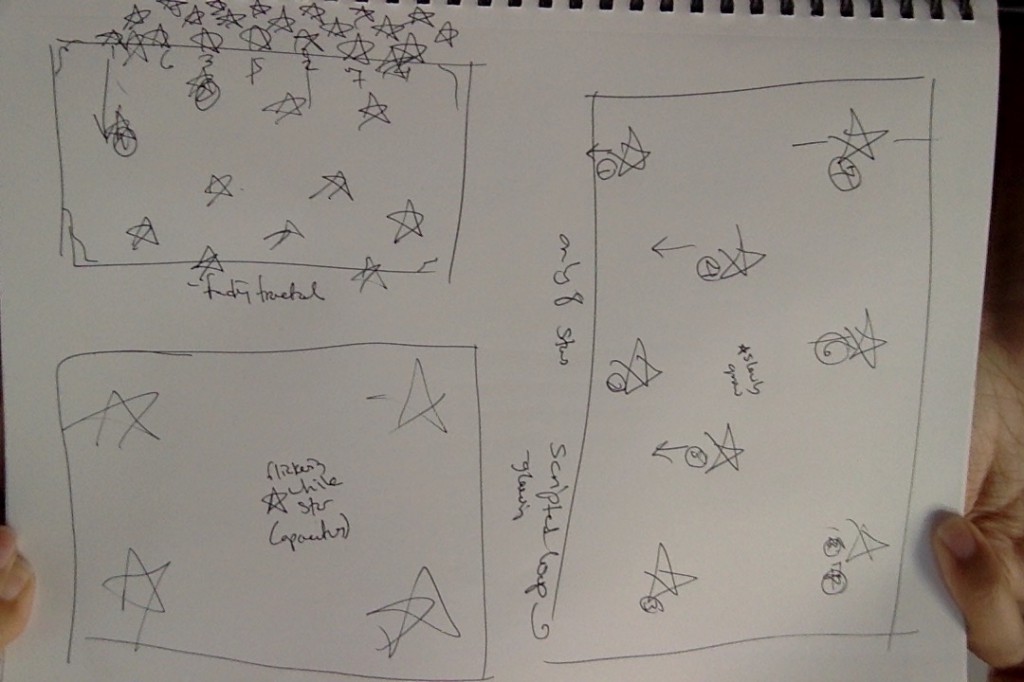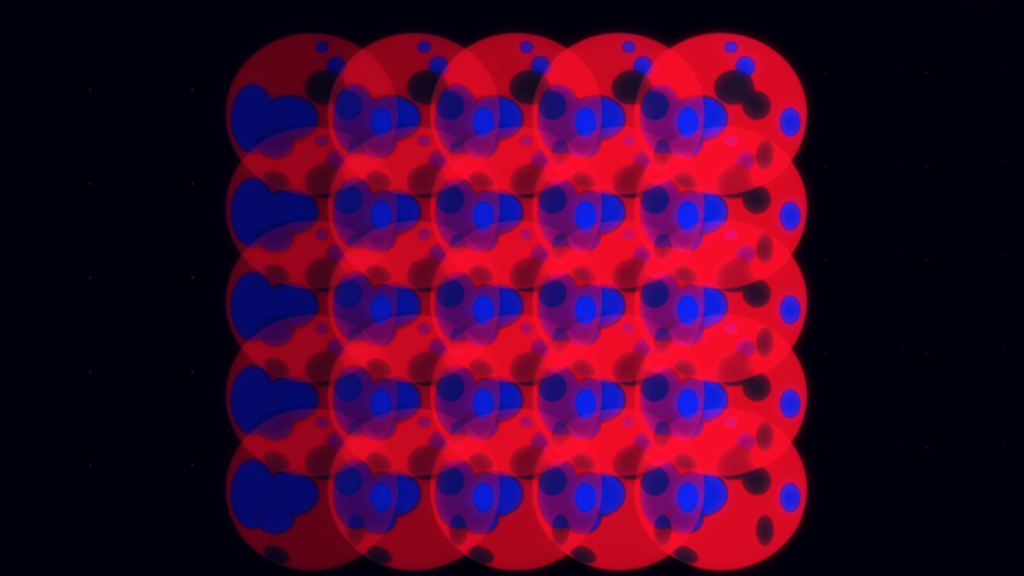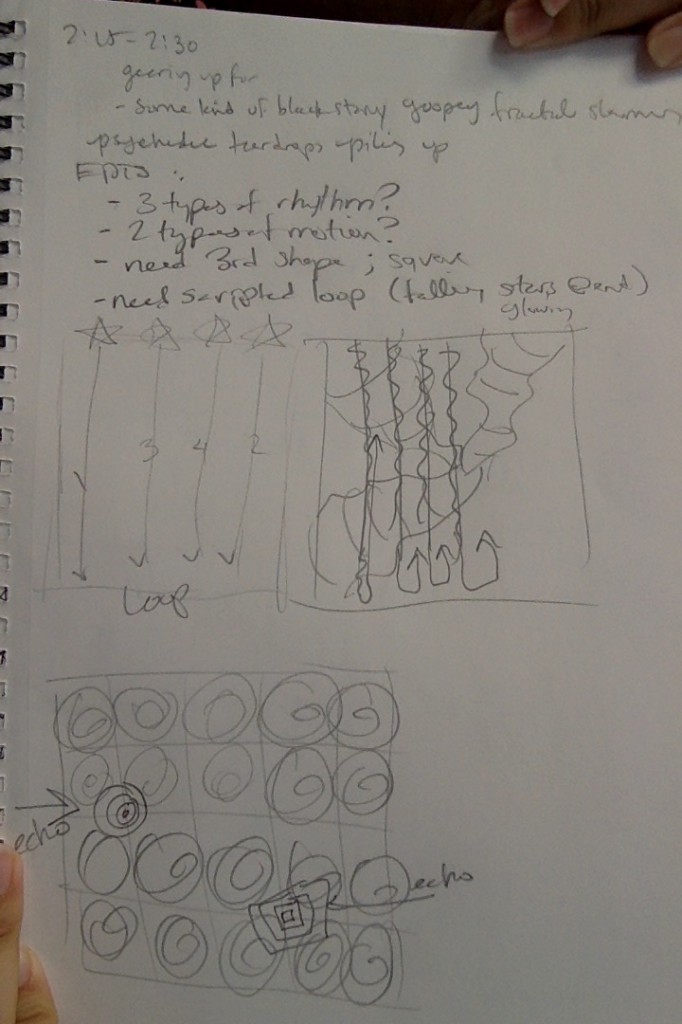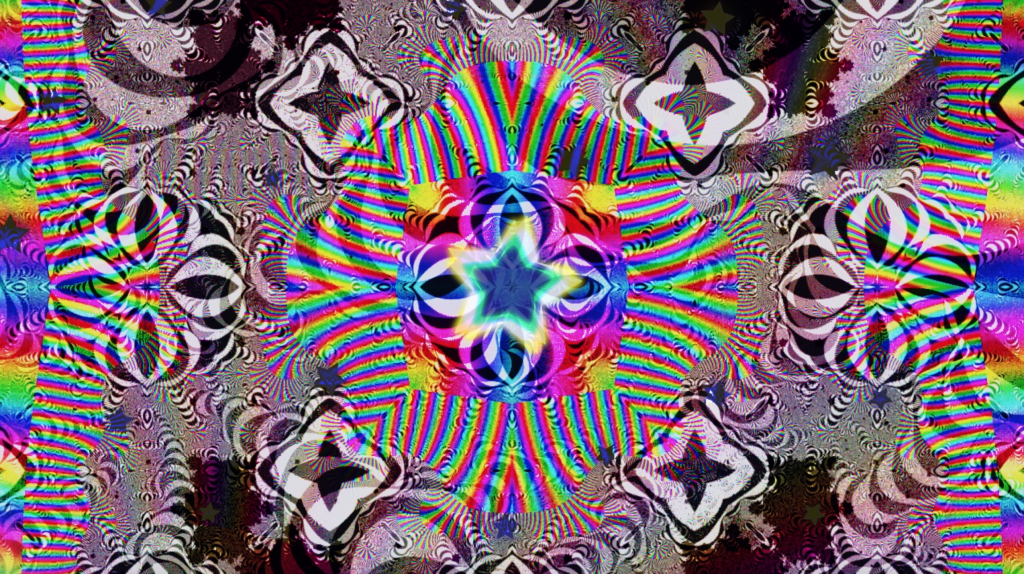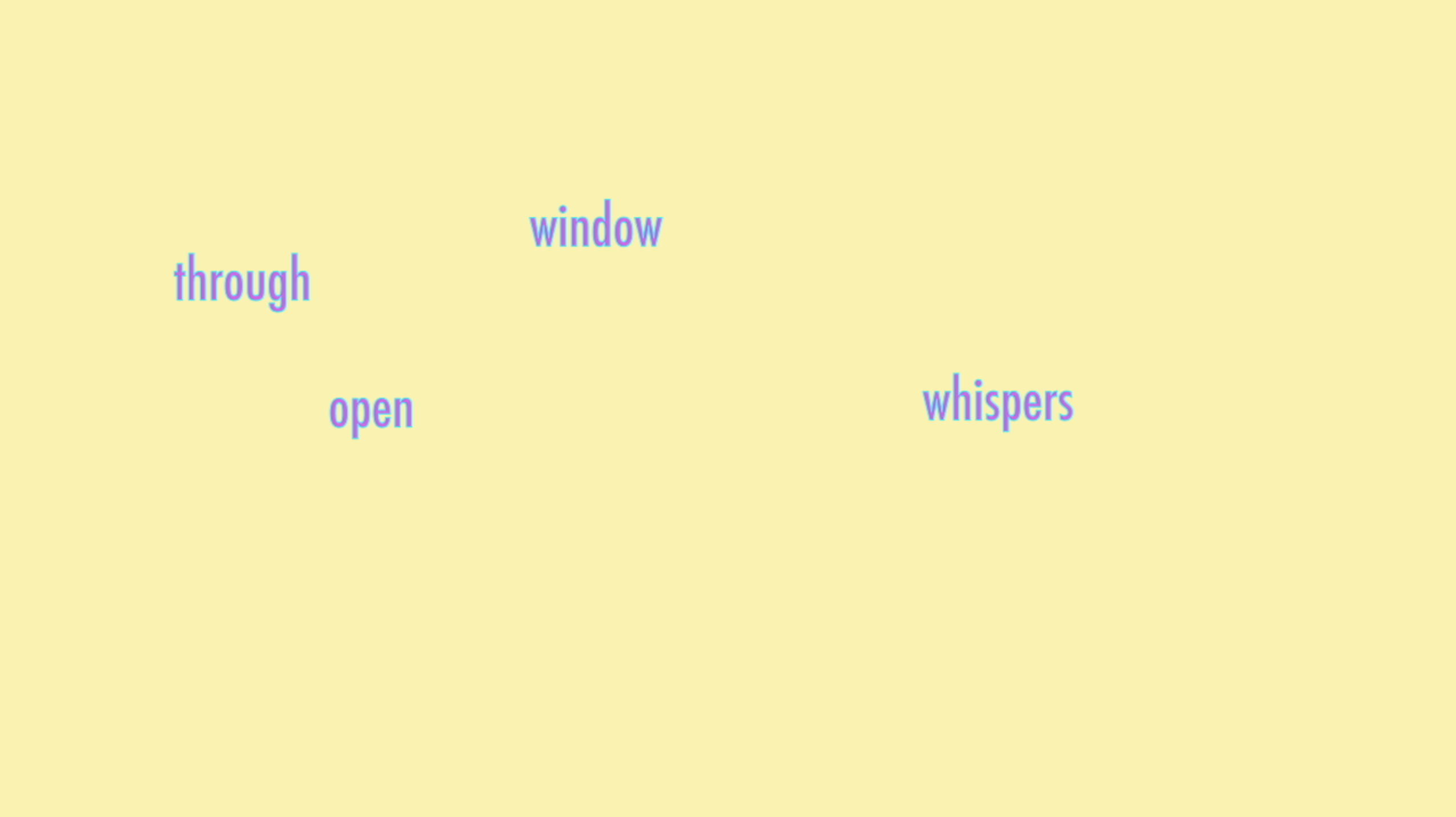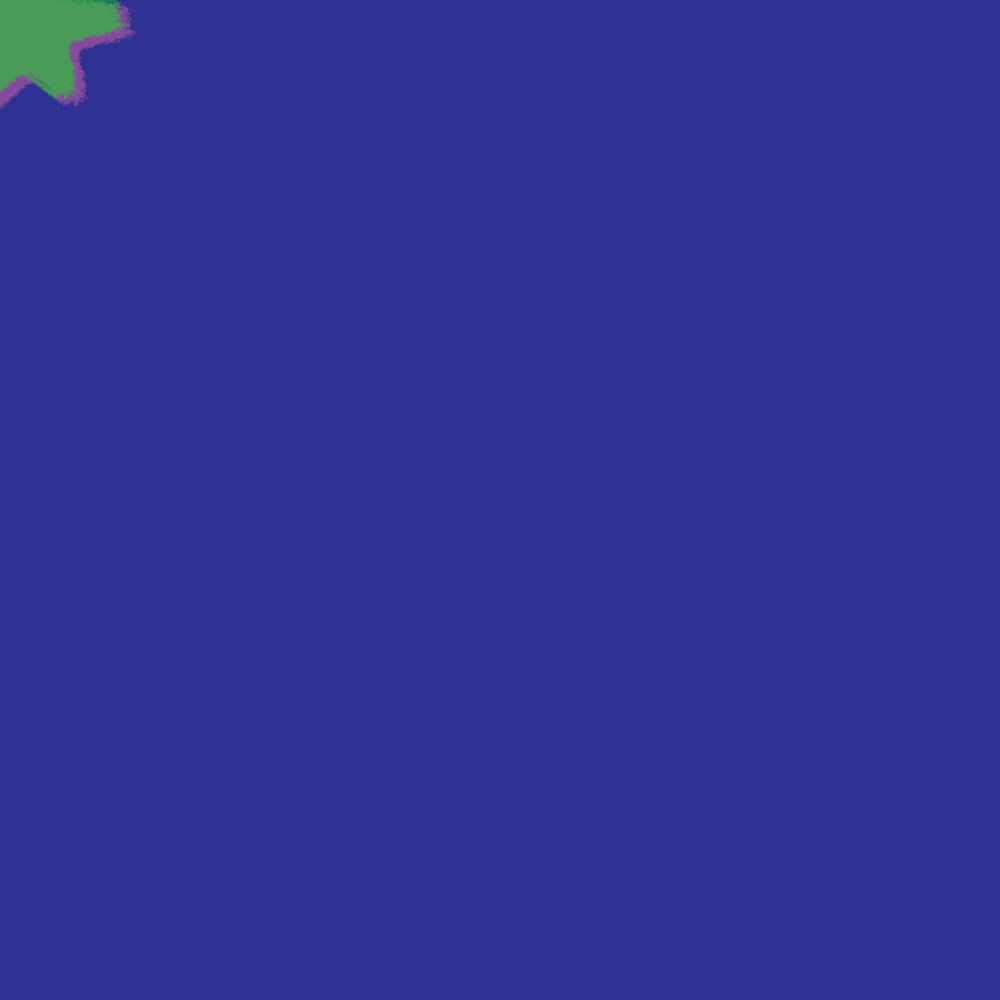When we were first given this assignment, I was going to do the song “Life on Mars” by David Bowie, but upon being given “Space Oddity” as the inspiration for the prompt I decided I should choose a song by a different artist, as a way to respond to Bowie with someone other than himself. My choice ended up being “The Handshake” by MGMT, which I chose because it met the length requirement, but also because its sound world is a bit psychedelic, and the lyrics have a poeticism that in some ways speak to the Bowie perspective on life.
Since the setting of “Space Oddity” is outer space, the obvious starting place for this work was the night sky. Originally, I thought the work would follow a narrative storyline where the viewer would “pass through a star” and move linearly into space, but I realized that this type of work – especially when there are fractals involved — lends itself better to a more abstract type of journey. I started making lists of concepts we learned in class and how I could build them into scenes that would respond to the changing cues in the music. Marking up the timeline with post markings right at the beginning of the project was very helpful; these became cues that I referred to throughout the process, from the very beginning until the end.
My design ideas came easily at first because the music I chose was generative and I was excited to try out my ideas in After Effects. My process began as a dialog between After Effects and my sketchbook, along with some math notes calculating time approximations for scenes and how to make transitions line up with the musical changes. I would come up with a scene that I imagined would fit the music and the narrative, and then try to figure out how I could transition from the previous idea to the new one. Most of what I imagined up front was not difficult to create in After Effects. As the process continued though, ideas became increasingly oriented around what I could make in After Effects, with the sketches being used more as a way to map out technical aspects of what I wanted to build. Sometimes I would end up sketching images, only to realize once I began building them that I would not be able to execute it in the program as easily as I thought.
The black stars were one instance where my vision had to stray from my execution. I knew from the beginning that I wanted to incorporate black stars as a subtle homage to Bowie, so I sketched a few ideas of how I could incorporate stars into some of the scenes I had been building. My sketch helped solidify the concept, but once getting into After Effects, I was faced with difficulty in making many black stars that fell at the rate and motion path that I envisioned. I got them close to how I had pictured, but not quite perfected. The final “downpour” part was where I compromised the most; rather than a downpour of stars falling down at once, I used a repeater and transformed them into a giant chunk. I made the chunk wiggle a bit to decrease its rigidity, but it still took on a character that was much different from my original vision for it, losing its star-ness and becoming more of an abstract shape. While this was a hurdle to overcome, it is also showed me how new artistic ideas can be born in the program.
The moon was one of the most satisfying elements for me, and it happened as a result of negotiating with After Effects. I had built the opening scene with the starry sky, introduced the big star that is a main character, and then transitioned into the first scene using fractals, where the rainbow fractals are moving rapidly in contrasting motion across the frame. When there is a change in the music, the fractal is “exited,” and the viewer is dumped back into open space, where the sky is black and the stars from the opening scene are still sitting, but dimmer than before. I thought that the scene needed another grounding character, so I built a moon out of shapes. This took way longer than expected, and when I finished, I was really disappointed in the result. I had been hoping to show some moon exploration here, but I found the moon’s character so embarrassing that I decided I needed to quickly abstract it – so I added a keyframe changing it red, and turning its “craters” blue and purple. From here, a new scene was born, where I added a repeater and turned the moon from a literal moon to a colorful shape that expands and contracts, and finally flattens down into a line. This type of play with dimensionality and representation would not have appeared on its own in my imagination, and came of my attempts to reconcile the difficulties I was facing with building images in After Effects. After this scene finishes, it goes back into a scene that I had built in my imagination and sketchbook, where the moon pops back up, and the viewer “enters” a crater, which is another fractal world. I’d like to think that David Bowie would appreciate the moon scene.
Because of the trajectory my workflow took, the most challenging part of this project was the editing process, and coming up with an ending. I did the bulk of the project very quickly, and through working so intensely with After Effects, my skillset and workflow actually became more advanced from the start of the project to the near finish. This resulted in part of the editing process being my compensating for elements that may have been constructed inefficiently and trying to figure out how to compensate for it, if I even could. Some parts, like the jerky motion path of the moon when it scales up and “comes toward” the viewer, were difficult to troubleshoot because of the way they had been keyframed, and even after fixing them, they are still a little jerkier than I would prefer. Other parts, like keyframes that lined up with sound cues were just tedious to adjust. I found myself sketching out more technical diagrams and listening to cues in the music repeatedly, trying to parse out the correct timing for each transition. Sometimes this led to rethinking whether the scenes I originally conceptualized actually flowed together after all the changes that they underwent – and that I underwent as a designer — during the building process. I think that now, having spent so much time in the program, I would have some more fluid ways of building a few of the elements that I used.
The only other outstanding issue with this work, for me, was the ending, which feels like it ran out of creative ideas. After all the time I spent working, I felt like I developed some “After Effects Fatigue” where I was up against a creative wall. To finish the video, I ended up using the kaleidoscope effect, and letting it take its time to play out. While the effect is visually pleasing, it doesn’t feel like it lives up to the rest of the creative ideas in the piece, and feels too stagnant. In the moment of creation, it felt like a satisfying idea, but in hindsight, I would have preferred to exit the kaleidoscope world much sooner, and pan back out into the night sky where more active ideas could play out, rather than just fading back into the night sky at the end, which is a much flatter visual idea. Still, being relatively new to After Effects, I feel mostly satisfied with the ideas I came up with and how I was able to fill the time and space of this piece. The biggest takeaway was that the more time I spend in After Effects, the more infinite the possibilities become for creating exciting and technically perfected work. The external inspiration of the music and of David Bowie himself were driving forces that pushed me to see how far I could take my creative ideas and expand my skillset.

